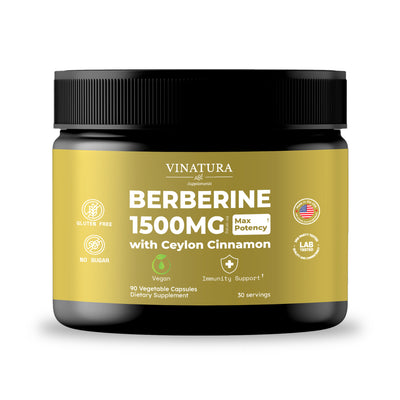
How To Use Goldenseal Root? Dosage And Timing
Goldenseal, a medicinal plant mainly found in North America, is famous for its medicinal properties. Its active ingredients are hydrazine and Berberine, which have antiseptic properties. Goldenseal is available in liquid, tablet, and capsule forms standardized to active ingredients. How to use goldenseal root effectively is a question that receives much attention. This article aims to provide valuable insights into this remarkable plant's appropriate dosage, timing and uses.
Before exploring further, please read the disclaimer located at the end of this webpage.
How to Use Goldenseal Root In the Traditional Uses

Goldenseal is a common natural remedy for upper respiratory tract infections, including the common cold.
Its antibacterial activity in vitro is believed to be due to its alkaloids, with Berberine being the most common. [1]
Studies on cell cultures in the laboratory and animals have shown that Berberine can help combat infections caused by bacteria and viruses, including common cold-causing viruses. [2]
Native Americans used Goldenseal to relieve irritations and inflammation in the respiratory, digestive, and urinary mucous membranes.
They often applied it topically for skin and eye infections and historically used it as a mouthwash to help heal canker sores.
Goldenseal is often combined with echinacea for colds and flu, primarily to ease sore throat discomfort. Early 20th-century Eclectic physicians valued Goldenseal as a remedy for stomach and intestinal problems.
How Do You Take Goldenseal Root?
Recommended Dosage for Goldenseal Root

Supplements from dried roots are typically used at doses ranging from 0.5 to 10 grams per dose per day, while alcohol tinctures and liquid extracts are commonly administered at doses of 0.3 to 10 mL three times a day. [3]
Goldenseal can also be consumed as a tea by steeping 2 teaspoons of dried herb in 1 cup (240 mL) of hot water for about 15 minutes.
The recommended dosage when using Goldenseal is 1 gram of pure Goldenseal powder extracted from the root.
Mix a quarter (¼) teaspoon of Goldenseal Powder (1 gram = 1000mg) into 8-10 oz of water to use. You can use it with juice or smoothies to increase it even more.
You can also take an empty capsule without water.
Goldenseal benefits include strengthening the immune system, promoting healthy sinuses, and supporting digestive health.
Ways to Take Goldenseal Root

How to Use Goldenseal Root Powder: You can use Goldenseal powder as a tea or tincture that can soothe a sore throat. It can be mixed with water or juice and taken orally. You can 'smell' up each nostril, and it will support the sinus areas.
How to Take Goldenseal Drops: Goldenseal is also used topically as a lotion, eye wash, ear drop, and vaginal douche and administered by placing drops under the tongue or mixing with water or juice.
How to Take Goldenseal Tincture: Typically taken by adding a few drops to water or juice and consumed orally.
Combine Goldenseal Root and Other Herbs: Goldenseal root is commonly blended with other herbs in herbal mixtures or teas to create synergistic effects. It is often combined with echinacea in different over-the-counter herbal remedies for colds and flu. Echinacea, native to North America, is widely utilized for treating infections, such as the common cold. [4], [5]
Other Forms of Goldenseal Root to Take: Capsules and tablets are also available for convenient oral consumption.
This video will provide you with comprehensive guide about the benefits of Goldenseal root and how to use Goldenseal root capsules effectively:
How to Take Goldenseal Root for Specific Condition
How to Use Goldenseal for Ear Infection: Goldenseal is used for ear problems like ringing, earaches, and deafness. It contains Berberine, which fights bacteria and fungi.
Based on early research, Berberine may also lower blood pressure, improve irregular heartbeats, reduce blood sugar, and lower "bad" LDL cholesterol levels. [3]
Goldenseal root extract can be diluted and applied topically to the affected ear for ear infections. Alternatively, it can be taken orally to support the immune system's response to infection.
How to Use Goldenseal Powder for Tinnitus: Goldenseal powder, when taken orally, may help ease tinnitus symptoms, but there is limited research on its effectiveness for this condition.
How to Use Goldenseal for Sinus Infection: Goldenseal root may help alleviate symptoms of sinus infections when taken orally or as a nasal rinse.
How to Use Goldenseal for Eyes: Goldenseal root is not commonly used for eye-related conditions, and caution should be exercised when using any herbal remedy near the eyes.
How to Use Goldenseal for UTI: Goldenseal root may help support urinary tract health and alleviate symptoms of urinary tract infections when taken orally.
Best Way to Take Goldenseal
There aren't any studies that suggest what dosages of Goldenseal are the most beneficial. Goldenseal supplements come in many forms so that dosages can vary.
Taking Goldenseal in capsule or powder form is supposed to be optimal. It can also be applied topically to the skin as an ointment, balm, or cream for rashes, itching, wounds, acne, eczema, and ulcers.
Frequently Asked Questions
Can You Take Goldenseal Daily?
While Goldenseal can be taken daily for short periods, it's not recommended for long-term use due to potential side effects and the risk of developing antibiotic resistance. Goldenseal may lead to side effects like nausea, vomiting, and impaired liver function. [6]
Can You Take Goldenseal While Pregnant?
Limited research suggests potential risks of using Goldenseal during pregnancy and breastfeeding. Animal studies indicate that Berberine, a key compound in Goldenseal, may lead to lower weight in mothers and babies, increase the risk of preterm birth due to uterine contractions, and worsen jaundice in newborns, possibly causing brain damage. [7]
What Not to Take with Goldenseal?
Goldenseal, especially its main component berberine, may interact with various medications, affecting their effectiveness or increasing the risk of side effects. It's crucial to consult a doctor before using Goldenseal if you're taking any prescription or over-the-counter drugs. Specific interactions include elevated levels of cyclosporine, increased blood levels of digoxin, potential reduction in the effectiveness of tetracycline antibiotics, and heightened risk of bleeding when used with blood thinners like Warfarin, Plavix, and Aspirin.
Conclusion
Goldenseal root has been used for centuries as a traditional medicine for various conditions. It is known for its many health benefits, including its ability to strengthen the immune system, support digestive health, and reduce sinus infections. This article has helped you learn how to use goldenseal root most effectively.
References
- [1] Ettefagh, K. A., Burns, J. T., Junio, H. A., Kaatz, G. W., & Cech, N. B. (2010). Goldenseal (Hydrastis canadensisL.) Extracts Synergistically Enhance the Antibacterial Activity of Berberine via Efflux Pump Inhibition. Planta Medica, 77(08), 835–840. https://doi.org/10.1055/s-0030-1250606
- [2] Chu, M., Ding, R., Chu, Z., Zhang, M., Liu, X., Xie, S., Zhai, Y., & Wang, Y. (2014). Role of berberine in anti-bacterial as a high-affinity LPS antagonist binding to TLR4/MD-2 receptor. BMC Complementary and Alternative Medicine, 14(1). https://doi.org/10.1186/1472-6882-14-89
- [3] Working, I. (2016). Exposure Data. Nih.gov; International Agency for Research on Cancer. https://www.ncbi.nlm.nih.gov/books/NBK350390/
- [4] HPLC ASSAY OF ECHINACEA PURPUREA/GOLDENSEAL (HYDRASTIS CANADENSIS) COMBINATION FORMULATIONS FOR PHENOLIC ACIDS, ALKYLAMIDES, AND ALKALOIDS. (2024). Journal of Liquid Chromatography & Related Technologies. https://www.tandfonline.com/doi/abs/10.1081/JLC-100108744
- [5] Catanzaro, M., Corsini, E., Rosini, M., Racchi, M., & Lanni, C. (2018). Immunomodulators Inspired by Nature: A Review on Curcumin and Echinacea. Molecules, 23(11), 2778–2778. https://doi.org/10.3390/molecules23112778
- [6] Goldenseal-Drug Interactions: A Concern? (2021, July 7). Naturalmedicinejournal.com. https://www.naturalmedicinejournal.com/journal/goldenseal-drug-interactions-concern
- [7] Rad, K., Rameshrad, M., & Hosseinzadeh, H. (2017). Toxicology effects of Berberis vulgaris (barberry) and its active constituent, berberine: a review. DOAJ (DOAJ: Directory of Open Access Journals), 20(5), 516–529. https://doi.org/10.22038/ijbms.2017.8676
Author

Product Disclaimer
Including an ingredient or study does not evaluate, endorse, or recommend any Vinatura product or any third-party product. Some ingredients discussed may not be used in any Vinatura product.
The content of the articles has not been evaluated by the Food and Drug Administration (FDA) and is not intended to promote or endorse any specific product. Any products sold on this website are not intended to diagnose, treat, cure, or prevent any disease.
Opinions and Endorsements
Any claims, statements, or opinions expressed in the articles are those of the author(s) and do not necessarily reflect the views or opinions of the manufacturers of the dietary supplement products. The products sold on this website are separate from the content of the articles and are not directly endorsed or associated with the information presented here.
Liability Disclaimer
The author(s) of the articles, website, and manufacturers of the dietary supplement products do not assume any liability for any potential consequences arising from the use of the information provided in the articles. Ingredient effects, dosages, and safety vary by individual, formulation, and context; some ingredients interact with medications or may be unsuitable during pregnancy or lactation. It is recommended that individuals consult with a qualified healthcare professional before making any dietary or lifestyle changes, including the use of dietary supplements.
Product Usage
Please refer to the product labels and packaging for specific usage instructions and guidelines for the dietary supplement products sold on this website.
Customer Support
For any concerns or questions regarding the dietary supplement products, please contact our customer support team, who will be more than happy to assist you.





Leave a Comment
Be the first to comment.
What do you think?